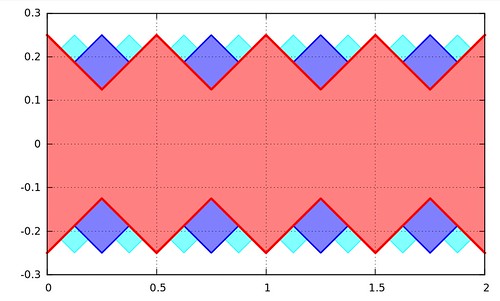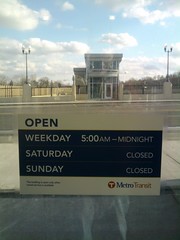Traffic simulation of buses in downtown Brooklyn, courtesy of Top Gear.
I had the day off on Friday, so I took the opportunity to check out some parts of the transit system in the Twin Cities that I usually don't see in action. Both my apartment and workplace are in between the two downtowns, and I do actually see (and hear) a huge number of buses each day, mostly coming from the bus barn just southeast of the State Fairgrounds. At work, we can look out the windows and see University of Minnesota shuttle buses ferrying passengers along the intercampus transitway.
Too bad I can't get on any of those buses (well, I could take a campus bus, but that's a 2-mile hike from my apartment).
Anyway, I had taken the 84 up to Rosedale for a late lunch, then rode the 260 from there and got my first taste of the Marq2 project from inside a bus. Marq2 is a pretty remarkable sight when it's running at full tilt. It reminded me of the scene when my brother and I first popped our heads out of the subway station in Brooklyn late last summer—Massive amounts of traffic including bus drivers jockeying for position as though they were driving sportscars. At least in Minneapolis there seemed to be less honking, and the buses were mostly going in the same direction.
I took a little detour to take a look at the
That turned out to be a more complicated than I expected. There wasn't any obvious big thick rapid transit line on the maps I found in downtown. I looked up the first stop for route 535 via a NexTrip app on my phone, but when I walked to the 3rd Ave & 2nd Street intersection, the stop was just a sign attached to a pole. In the schedule information, I think it simply said "MVTA" and "SouthWest" or something like that. No positive reinforcement at all—I wasn't sure whether I should be looking for an MVTA bus, a Metro Transit one, or something else entirely.
I gave up, wandered over to Nicollet, and got on the slow route 11 bus instead. 40 minutes later, I got off at the 46th Street station.
I was a little miffed that the first thing I saw was a schedule showing how the place is closed on weekends. The bus system in the Twin Cities is heavily geared toward the rush-hour crowd, even though that only represents a fraction of overall travel. I won't be able to consider any bus service in the Twin Cities "bus rapid transit" until it operates on the weekends, (and still frequently).
Anyway, I wandered down to the freeway level, and expected to find a map of where the services go, but got shafted on that front. There was a listing of the different buses that serve the station, mostly route 535, but the only map seemed to just be a zoomed-in view of Metro Transit's normal system map, which is fairly unintelligible for route 535 service. The next southbound 535 bus was due to arrive shortly, and the next one wasn't going to show up for 20 or 30 minutes after that, so I took the opportunity to head south. One thing I did notice as the bus pulled up was that the pedestrian pavement seemed to be lower than normal—rather than raising the height to create an LRT-like platform to facilitate level boarding, it seems that designers went the opposite way, making me have to step up quite high to board a low-floor bus! That was pretty idiotic, in my opinion.
I must have picked the last 535A bus of the day or something. Lacking any sort of intelligible map, I wasn't sure where the Knox Park & Ride was, so I figured the bus would go down to the Southtown shopping center and continue onward. However, it turns out that the park-and-ride is basically on the campus of the Best Buy headquarters, before the bus would reach Southtown! I'm surprised that Best Buy decided to allow space for a park & ride, though it is annoyingly located way down next to I-494. It seems that route 535 buses all go and turn around at this lot, a quarter-mile south of 76th Street, before continuing on to other sites (for every route except the 535A), but the exact method of operation is somewhat of a mystery—when I headed back north, the 535 bus (all northbound buses are simply 535, no matter where they start from) skipped the turn down to the park-and-ride, so maybe I'm misreading things.
I'd hate to be a person who parked at the official park-and-ride and was waiting for a bus that only went 1/4 mile away. I figure it would be better for Best Buy to designate a segment of their big parking garage for transit riders instead of having buses go down and make a half-mile detour to jab at a lot farther to the south. Yes, I'm an advocate of increasing stop spacing, but I don't think it's a good idea to force absolutely everyone to walk their maximum tolerable distance all the time.

A graph showing pedestrian sheds for bus stop spacing of 1/8-, 1/4-, and 1/2-mile, respectively. While increased spacing decreases the population within 1/4 mile of a stop, the resulting speed improvement more than makes up for increased walking time/distance.
Anyway, a lot of fairly free-flowing traffic has made me re-evaluate my previous thoughts about stop spacing a little bit. While my own regular route 3 tends to get slowed a lot by passengers showing up at random locations, I did notice it went pretty fast in the evening as I came home. The biggest gains in speed from increasing stop spacing would occur during rush hours—there's generally less gain to be had in the off-hours. A lot of the game has to do with perception, though—it's important to provide the best rider experience possible whether they use the service during rush hours, midday, evenings, or weekends. With the ubiquity of cars, it doesn't take much to turn people off. Being inside a bus while it makes unnecessary turns or does other things that waste time tends to drive people away.
In my previous post about how much time could be saved, I didn't really think about the fact that service often runs with little delay in off hours or other (fairly random) periods, so my perception of how much time could be saved was probably a bit off. It would still be a noticeable improvement, though.
I'd really like to see frequent limited-stop bus service running along the highways in the Twin Cities (oh, did I mention that the 535 is officially a limited-stop service with the same fare as a local route? That's one good thing, I guess.) Anywhere that a major highway meets another road with a diamond interchange should probably have a bus stop with service running every half hour. No need to go and spend millions on a BRT station (at least not right away). Making use of existing high-speed infrastructure is a good way to improve user perception of service. That's my opinion, anyway...

No comments:
Post a Comment